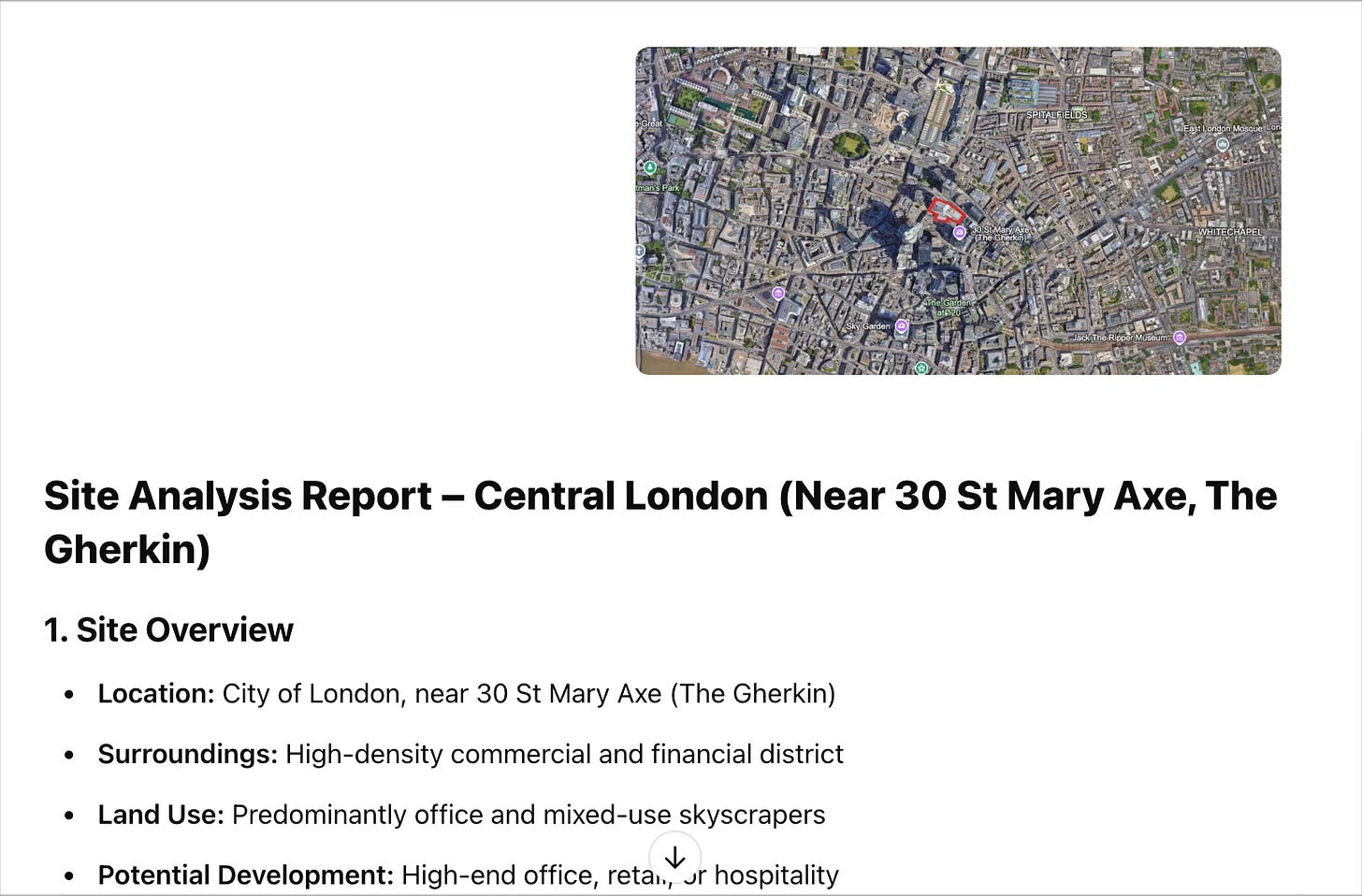AI-Powered Site Research: How Developers Can Cut Hours Down to Minutes
Discover how to build a Custom GPT that streamlines your workflow (no coding needed)
Recent Popular Posts
Automation, On-Shoring and the Future: Dark Warehouses Are the Next Big Industrial Revolution
Brace for Impact: 5 Ways U.S. Tariffs Could Shake Up Real Estate in 2025
Welcome to The LineUp! Our weekly newsletter seeks to add value by engaging, connecting, and inspiring real estate operators, investors, and entrepreneurs. If you enjoy what you read, please like, share, and subscribe. Thank you for your support in growing this community! If you’d like to participate in our conversation join us on the Substack Chat here.
This post is a guest post, written by Carlo Benigni for The LineUp. Be sure to check out Carlo’s Substack to follow him Unlocking Real Estate Value here! His choice of topic speaks to how we as real estate professionals can use AI to unlock time and value in our workflows. Enjoy and let me know if you have any topics you would like to contribute in upcoming posts on The LineUp. Cheers, John
(Source: Ideogram)
In this newsletter, I’ll show how developers and real estate professionals can use ChatGPT to accelerate the site research process. When I worked at Brookfield Properties, we spent significant time researching data about potential and acquired sites as part of our internal Development Option Analysis process.
Site analysis was a fundamental step that mapped out key information about a location for both internal and external communication. Fifteen years ago, this process was entirely manual (mostly done by me!). Research was the most time-consuming aspect, involving reviews of local planning regulations, heritage maps, key planning consents, and zoning plans. We then had to package this information so it could be easily communicated.
Now, with ChatGPT, the site research process can be fully automated with a GPT assistant. My goal in this article is to demonstrate how easy it is to create your own Custom GPT using site analysis as an example. Believe it or not, this Site Research Assistant can reduce hours of work to just five minutes.
This newsletter will answer the following questions:
What are the 3 key benefits of using a Custom GPT for site research?
How can you build your own Site Research GPT (step-by-step guide, no coding needed)?
What lessons have been learned from using a GPT, and what can be improved?
Let’s dive in.
1. What Are the 3 Key Benefits of Using a Custom GPT for Site Research?
Creating a Custom GPT for automating site research is particularly useful if this is a task you perform repeatedly. Mapping out key information about a site helps create a mental image of its potential. However, conducting research manually is time-consuming and takes away from time that could be spent brainstorming development ideas.
Based on my experience, here are the three main benefits of using ChatGPT for site analysis:
Speed – The GPT accelerates research, providing a complete set of key site data within minutes.
Preparation – It helps you get ready for site visits by offering deeper insights into a location, accessible via smartphone on the go.
Report Generation – The research is delivered in a ready-to-use report format, perfect for presentation decks or sharing with your team.
Using a Custom GPT allows you to analyse 10 times more sites in an hour compared to manual research.
(Source: ChatGPT)
Here is the initial full response from ChatGPT:
Site Analysis Report – Central London (Near 30 St Mary Axe, The Gherkin)
1. Site Overview
Location: City of London, near 30 St Mary Axe (The Gherkin)
Surroundings: High-density commercial and financial district
Land Use: Predominantly office and mixed-use skyscrapers
Potential Development: High-end office, retail, or hospitality
2. Sun Path & Orientation
Sun Exposure: The site is surrounded by tall buildings, which may create shadows during parts of the day.
Optimal Facades: The site benefits from southern and western sun exposure for natural daylight, making these ideal for public-facing spaces such as offices or retail areas.
Design Considerations:
Maximize glazing on south-facing facades to enhance daylight and energy efficiency.
Consider rooftop solar panels or green terraces for sustainable energy use.
3. Transportation & Connectivity
Public Transport Access:
Nearby Tube Stations:
Liverpool Street Station (Central, Circle, Hammersmith & City, Metropolitan lines) – 5-minute walk
Aldgate Station (Circle, Metropolitan lines) – 5-minute walk
Bank Station (Central, Northern, DLR) – 10-minute walk
Buses: Multiple bus routes connecting to Greater London.
Cycling & Pedestrian Access:
Well-integrated cycling infrastructure with Santander Cycles docking stations nearby.
Pedestrian-friendly environment with high footfall.
Vehicular Access:
Limited parking availability due to central location and congestion zone restrictions.
Encourages public transport and active travel options.
4. Demographics & Amenities
Target Market:
High-income professionals, financial sector employees, and corporate firms.
Tourists due to proximity to major landmarks.
Nearby Amenities:
Commercial Hubs: Close to major financial institutions, tech companies, and corporate offices.
Dining & Retail: Walking distance to premium restaurants, bars, and shopping options.
Hotels & Hospitality: Presence of luxury hotels catering to business travelers.
Cultural Landmarks:
Sky Garden
Leadenhall Market
Spitalfields Market
Tower of London (15-minute walk)
5. Views & Visual Appeal
Key Landmarks Visible:
The Gherkin (30 St Mary Axe) – Directly adjacent to the site, offering a prestigious business location.
Tower 42 & The Cheesegrater (122 Leadenhall Street) – Part of the London skyline.
Skyline Potential: Upper floors of any development could offer premium views of the City and Canary Wharf.
Architectural Considerations:
Use glass facades to take advantage of skyline views.
Incorporate rooftop or terrace spaces to enhance visual appeal for tenants or guests.
6. Development Potential & Recommendations
Best Use for the Site:
Grade A Office Space – Given the financial district location, premium office space would attract global firms.
Luxury Mixed-Use Development – Combining office, retail, and hospitality to maximize returns.
High-End Hospitality (Hotel or Serviced Apartments) – Given demand from business travelers.
Retail & F&B Hub – Targeting professionals and tourists for dining and leisure.
Key Design Strategies:
Sustainable architecture with energy-efficient features.
Smart building technology to attract high-end tenants.
Integration with existing city infrastructure and transport hubs.
7. Conclusion
The site’s prime location within London’s financial district makes it ideal for premium commercial or mixed-use development. Given its accessibility, prestigious surroundings, and skyline potential, a high-rise office, luxury hotel, or flagship retail space would be the best development options. Future design should prioritize sustainability, views, and seamless integration with the City’s evolving urban fabric.
2. How to Build Your Own Site Research GPT (Step-by-Step Guide, No Coding Needed)
Creating a Custom GPT is simple and takes just a few minutes. Think of Custom GPTs as “mini-applications” within your ChatGPT account. These GPTs retain a set of custom instructions that you can use repeatedly without having to rewrite long prompts.
My Objective When Creating a Site Research GPT:
The ability to upload a Google Earth image with a site markup.
A GPT-generated Site Analysis Report highlighting key location data.
(Source: Google Earth)
Step-by-Step Process to Create a Custom GPT:
Access GPT Creation – Inside the GPT section of ChatGPT, select “Create a GPT.”
Define Your GPT’s Purpose – In the “Create” tab, describe what you need the GPT to do. For example:
Hey ChatGPT, I need help creating a GPT to research facts and information about locations marked on a Google Earth image.
I would like the GPT to output an analysis of the location in a report format including:
- Distances from transport connections.
- Distance to important landmarks.
- Sun path in relation to the site.
- Major roads.
- Key pedestrian routes.
Upload Background Information – If necessary, provide relevant documents in the “General Knowledge” section, such as:
Planning legislation
Building regulations
Climate/environmental data
Demographic reports
Any region-specific information
Test and Refine – Run tests to ensure the GPT delivers quality responses. Adjust prompts and inputs as needed.
Deploy and Use – Once satisfied, your GPT is ready for use. The more you use it, the better you’ll understand how to refine it further.
This is a screenshot of the GPT Builder interface inside ChatGPT (Source: ChatGPT)
3. Lessons Learned from Using a Custom GPT and What Can Be Improved
After using ChatGPT intensively for the past 14 months and creating multiple Custom GPTs (including this one), here are some key takeaways:
Lessons Learned:
Treat the GPT as an assistant – It enhances efficiency but still requires human oversight.
Garbage in, garbage out – The quality of output depends on well-structured input.
Always verify responses – Cross-check results for accuracy.
Beware of AI “hallucinations” – The GPT may sound confident even when incorrect.
Geographic limitations exist – The same Site Analysis GPT may not perform well across all regions.
Areas for Improvement:
Create region-specific GPTs – Developing dedicated Site Analysis GPTs for different regions or cities will enhance accuracy.
Refine knowledge files – Uploading detailed regional data ensures the GPT delivers more precise results.
Improve report formatting – Adjust GPT instructions so the generated report is 90% presentation-ready.
Conclusion
Custom GPTs are a game changer when applied to micro-tasks that occur repeatedly in a workflow. They are flexible tools that can be continually refined for better performance.
Key Takeaways:
ChatGPT makes site research and analysis significantly faster – Time saved can be reinvested in brainstorming development ideas.
Custom GPTs automate site research – They function as reusable mini-apps.
You can generate a Site Analysis Report in minutes – Delivering a 90% presentation-ready draft.
Always review GPT outputs – AI-generated responses should not be blindly trusted.
Today, we used site analysis as an example. However, GPTs can be applied to many other repetitive micro-tasks, such as:
Reviewing legal documents
Drafting scopes of work
Writing investment memos
Summarising key actions from a video call
By leveraging Custom GPTs, you can automate repetitive tasks and focus your energy on high-value strategic decisions.
Thank you for reading The Lineup. Do you have a topic on real estate development, entrepreneurship, urbanism or placemaking topic you'd like to see us cover in an upcoming post? We'd love to hear from you! We are also open to media partnerships and cross-posts. Reach out to us at info@pughmgmt.com. And don't forget to like, share, and subscribe!
If you like The LineUp, let’s connect: Join our chat conversation on Substack here. Plan a media partnership | 🪄Book a one-on-one intro call to learn more about Our Real Estate Consulting here | 📧 Subscribe at thelineupwithjohnpugh.substack.com
This post is sponsored by Pugh Management a leader in real estate investment and development. We primarily work with family offices and ultra-high net worth individuals to invest in real estate. To learn more reach out to us at info@pughmgmt.com or click this link to our website.










